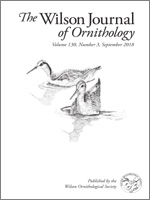We present the first detailed account of the breeding biology and egg description of the Restinga Tyrannulet (Phylloscartes kronei). Restinga Tyrannulets build their nests (n = 10) 0.7–3.0 m above ground level. The nests were closed and ovoid, with an interior of dry grass leaves and an exterior covered with moss, all adhered with spider webs to fix the nest material. Nest chambers were lined with plumose seeds. Nest construction lasted ∼19 d and was apparently accomplished exclusively by females. We recorded a clutch size of 2 to 3 white eggs (15.9–16.8 × 12.7–13.1 mm). Incubation was performed only by females and lasted ∼12 d (constancy of incubation = 0.4), but both adults fed the nestlings and fledglings and removed fecal sacs from the nests. Nests and eggs were within the general pattern found for genus Phylloscartes. Female P. kronei had a more important role than males during the breeding period and seemed to be solely responsible for nest construction, which differs from reports for other Phylloscartes species.
How to translate text using browser tools
1 September 2018
Breeding biology of the Restinga Tyrannulet (Phylloscartes kronei)
Carlos O. A. Gussoni,
Marco A. Pizo
ACCESS THE FULL ARTICLE





